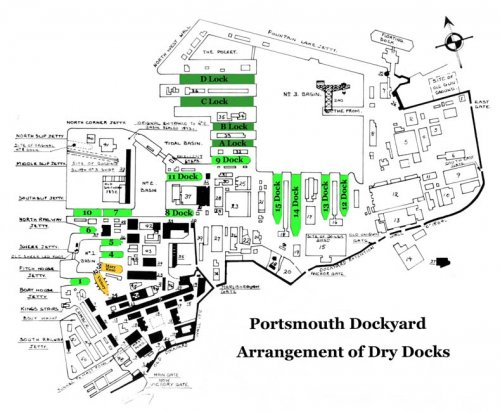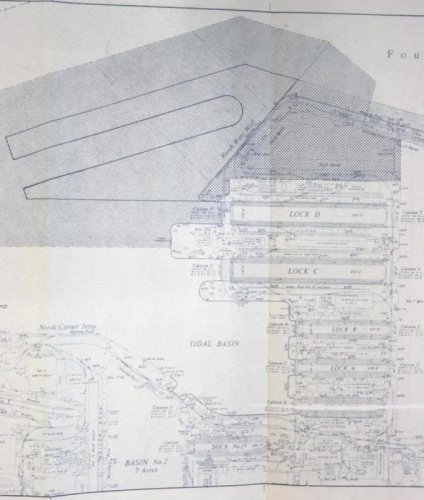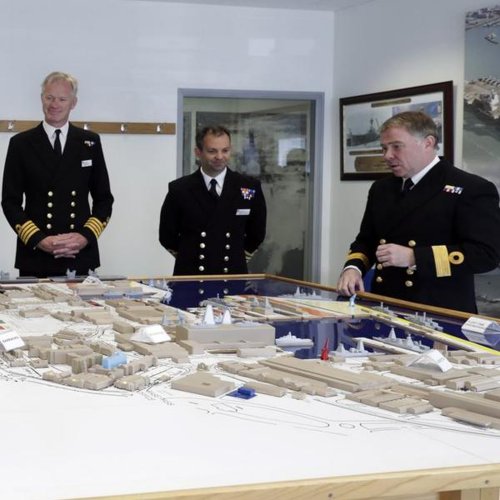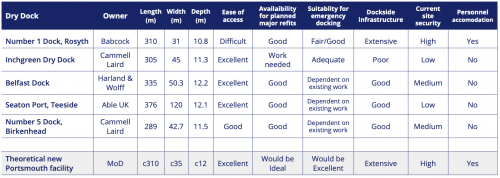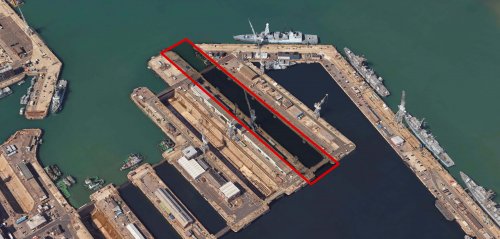Pirate Pete
ACCESS: Secret
- Joined
- 25 July 2007
- Messages
- 328
- Reaction score
- 500
The following article appears in the Portsmouth News 28/01/19:
Unfortunately, think it may be more wishful thinking than reality.....
Link to article: https://www.portsmouth.co.uk/news/defence/royal-navy-drawing-up-plans-for-new-mega-dry-dock-in-portsmouth-for-hms-queen-elizabeth-1-8786406
The link to Portsmouth New does unfortunately result in some 'extras' - The Portsmouth News website is not one of the best!!
I have therefore 'extracted' the principle text to make it easier for member to read:
Royal Navy drawing up plans for new mega dry dock in Portsmouth for HMS Queen Elizabeth
TOM COTTERILL Email Published: 10:19 Monday 28 January 2019
AMBITIOUS plans are being drawn up by the Royal Navy to build a new mega dry dock capable of housing Britain’s new aircraft carriers in a venture that could be worth hundreds of millions for Portsmouth. The complex proposals are being crafted by an expert team of engineers and could see Portsmouth Naval Base’s Number 2 Basin converted into one of the country’s biggest dry docks, sources have told The News. HMS Queen Elizabeth could be getting a dry dock for major refits in Portsmouth under new plans being looked at by the Royal Navy.
Excited city leaders claim the project, which is still in the early phases of development, could create up to 100 jobs and bring £1bn to Portsmouth over the next decade.
Officials within the Royal Navy said it was too early to say if the plan was viable but admitted it was being looked into. However, if formally approved by the Ministry of Defence, the revamp would make the naval HQ one of the most capable in the world, able to refit everything from small boats to frigates, destroyers and Britain’s two £3.1bn aircraft carriers.
HMS Queen Elizabeth is only able to go to dry dock in Rosyth for major repair work.
Penny Mordaunt, Portsmouth North MP, hoped the project would bring a raft of benefits to the city. The international development secretary said: 'The vision to become the maritime heart of the UK is coming alive.'
Councillor Donna Jones, former leader of Portsmouth City Council, was excited by the prospect, which she said could ‘create and protect at least 100 jobs’ and be worth £1bn to the city over a 10-year period. The Tory leader also hinted there could be commercial gains to be had from civilian refits and added: ‘We already have one of the most sophisticated dockyards in the world and a key Nato asset globally, however the creation of a “super dry dock” in Portsmouth would make HM Naval Base Portsmouth one of the top three in Europe and one of the best in the world. ‘Being able to compete with areas like Rotterdam, which carries out a large amount of the commercial shipping re-fit work, would create hundreds of new jobs in Portsmouth. ‘I have spoken to the Royal Navy about this project and I am optimistic that the business case will demonstrate that the investment is a good one.’ Portsmouth will be the home of the navy’s two Queen Elizabeth-class aircraft carriers, HMS Queen Elizabeth and HMS Prince of Wales for the next 50 years.
However, when major refits are needed in a dry dock, the vessels would have to travel up to Rosyth, in Scotland. If the work to improve Portsmouth’s facilities were given the go-ahead, dockyard sources have told The News it could take up to five to fully realise the plans. The new facility would be large enough to house one of the 280m, 65,000-tonne behemoths, and allow engineers to access the hull and propulsion systems. A spokeswoman for the Royal Navy confirmed they were looking at the plan for a dry dock but said: ‘The options to deliver the best value engineering and infrastructure support for the Queen Elizabeth-class carriers remain under consideration. If is far too early to have any indication of the results.’ More than £100m has been pumped into modernise the dockyard to prepare it for the arrival of both aircraft carriers. It comes in the wake of a major investment in the base by defence giant BAE Systems, which maintains Britain’s naval fleet in Portsmouth.
The latest news strengthens Portsmouth’s hand to become a key maintenance hub of the Royal Navy’s future fleet. Campaigners have been battling to have to ensure the base has its fair share of refit work on the eight Type 26 frigates, the navy’s new state-of-the-art work horses which will help protect the aircraft carriers. The sub-hunting vessels will be packed with sophisticated sensors and weapons but will be based at Devonport Naval Base in Plymouth. However, as previously revealed by The News, sources within the MoD said Portsmouth was still in with a strong chance to secure lucrative maintenance contracts for the warships. HMS Queen Elizabeth is due for her first major period of dry dock maintenance later this year in Rosyth. Her sister ship, HMS Prince of Wales is expected to arrive in Portsmouth by the end of 2019.
For those of our members who are not familiar with the layout of Portsmouth Dockyard (or as it is now titled H.M.Naval Base, Portsmouth), I have included a plan of the dockyard (please note that this is somewhat dated from the perspective that the building slip and numbers 7 and 10 dry-docks have all been filled in.
Unfortunately, think it may be more wishful thinking than reality.....
Link to article: https://www.portsmouth.co.uk/news/defence/royal-navy-drawing-up-plans-for-new-mega-dry-dock-in-portsmouth-for-hms-queen-elizabeth-1-8786406
The link to Portsmouth New does unfortunately result in some 'extras' - The Portsmouth News website is not one of the best!!
I have therefore 'extracted' the principle text to make it easier for member to read:
Royal Navy drawing up plans for new mega dry dock in Portsmouth for HMS Queen Elizabeth
TOM COTTERILL Email Published: 10:19 Monday 28 January 2019
AMBITIOUS plans are being drawn up by the Royal Navy to build a new mega dry dock capable of housing Britain’s new aircraft carriers in a venture that could be worth hundreds of millions for Portsmouth. The complex proposals are being crafted by an expert team of engineers and could see Portsmouth Naval Base’s Number 2 Basin converted into one of the country’s biggest dry docks, sources have told The News. HMS Queen Elizabeth could be getting a dry dock for major refits in Portsmouth under new plans being looked at by the Royal Navy.
Excited city leaders claim the project, which is still in the early phases of development, could create up to 100 jobs and bring £1bn to Portsmouth over the next decade.
Officials within the Royal Navy said it was too early to say if the plan was viable but admitted it was being looked into. However, if formally approved by the Ministry of Defence, the revamp would make the naval HQ one of the most capable in the world, able to refit everything from small boats to frigates, destroyers and Britain’s two £3.1bn aircraft carriers.
HMS Queen Elizabeth is only able to go to dry dock in Rosyth for major repair work.
Penny Mordaunt, Portsmouth North MP, hoped the project would bring a raft of benefits to the city. The international development secretary said: 'The vision to become the maritime heart of the UK is coming alive.'
Councillor Donna Jones, former leader of Portsmouth City Council, was excited by the prospect, which she said could ‘create and protect at least 100 jobs’ and be worth £1bn to the city over a 10-year period. The Tory leader also hinted there could be commercial gains to be had from civilian refits and added: ‘We already have one of the most sophisticated dockyards in the world and a key Nato asset globally, however the creation of a “super dry dock” in Portsmouth would make HM Naval Base Portsmouth one of the top three in Europe and one of the best in the world. ‘Being able to compete with areas like Rotterdam, which carries out a large amount of the commercial shipping re-fit work, would create hundreds of new jobs in Portsmouth. ‘I have spoken to the Royal Navy about this project and I am optimistic that the business case will demonstrate that the investment is a good one.’ Portsmouth will be the home of the navy’s two Queen Elizabeth-class aircraft carriers, HMS Queen Elizabeth and HMS Prince of Wales for the next 50 years.
However, when major refits are needed in a dry dock, the vessels would have to travel up to Rosyth, in Scotland. If the work to improve Portsmouth’s facilities were given the go-ahead, dockyard sources have told The News it could take up to five to fully realise the plans. The new facility would be large enough to house one of the 280m, 65,000-tonne behemoths, and allow engineers to access the hull and propulsion systems. A spokeswoman for the Royal Navy confirmed they were looking at the plan for a dry dock but said: ‘The options to deliver the best value engineering and infrastructure support for the Queen Elizabeth-class carriers remain under consideration. If is far too early to have any indication of the results.’ More than £100m has been pumped into modernise the dockyard to prepare it for the arrival of both aircraft carriers. It comes in the wake of a major investment in the base by defence giant BAE Systems, which maintains Britain’s naval fleet in Portsmouth.
The latest news strengthens Portsmouth’s hand to become a key maintenance hub of the Royal Navy’s future fleet. Campaigners have been battling to have to ensure the base has its fair share of refit work on the eight Type 26 frigates, the navy’s new state-of-the-art work horses which will help protect the aircraft carriers. The sub-hunting vessels will be packed with sophisticated sensors and weapons but will be based at Devonport Naval Base in Plymouth. However, as previously revealed by The News, sources within the MoD said Portsmouth was still in with a strong chance to secure lucrative maintenance contracts for the warships. HMS Queen Elizabeth is due for her first major period of dry dock maintenance later this year in Rosyth. Her sister ship, HMS Prince of Wales is expected to arrive in Portsmouth by the end of 2019.
For those of our members who are not familiar with the layout of Portsmouth Dockyard (or as it is now titled H.M.Naval Base, Portsmouth), I have included a plan of the dockyard (please note that this is somewhat dated from the perspective that the building slip and numbers 7 and 10 dry-docks have all been filled in.

